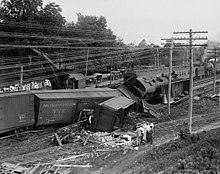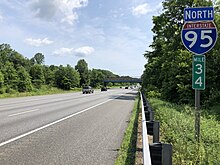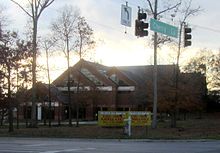Laurel, Maryland
The Department of Defense has a prominent presence in the Laurel area today, with the Fort Meade Army base, the NSA and Johns Hopkins' Applied Physics Laboratory all located nearby.
[3] The site, which among other finds has yielded fossilized teeth from Astrodon and Priconodon species, has been called the most prolific in the eastern United States.
[5] Laurel was formed from land on the fall line of the Patuxent River patented by the Snowden family in 1658 as part of the 12,250-acre New Birmingham plantation, which included the later Montpelier.
In 1835, coinciding with the opening of the Capital Subdivision rail line from Baltimore to Washington, the Patuxent Manufacturing Company was chartered by Horace Capon, Edward Snowden, Theodore Jenkins, W.C. Shaw, A.E.
The town was incorporated in 1870 and reincorporated in 1890 to coincide with a new electric power plant and paved streets and boarded sidewalks.
The building was converted to a movie theatre in 1915, with a parking garage on the lower floor of the wood structure; it burned in 1917, and Academy Ford built on the same site in the late 20th century.
[21] In 1888 inventor David J. Weems tested an unmanned electric train on a two-mile banked circular track near Laurel Station.
Charles H. Stanley was the bank's first president, and it remained independently managed and with the same name until acquired by PNC Financial Services in 2007.
With only bucket brigades, Mayor Phelps telegraphed Baltimore to send a special train with fireman, horses, and engine number 10.
The original building built for $5,000, now known as the Phelps Community Center, still stands at the northeast corner of Montgomery and Eighth Streets.
In the book, Seabiscuit: An American Legend, Laurel is mentioned several times as an important horse racing venue.
Laurel also hosted a horse trotter (harness racing) track named Freestate Raceway from 1948 to 1990;[35][36] it was located in Howard County on the west side of US Route 1, south of Savage in an area that now includes a CarMax dealership, Weis supermarket, and a strip mall.
In March 1912, the city agreed to take out $35,000 in loans to build its first sewer system with twelve miles of line that terminated by dumping into the Patuxent River.
She was joined by a Laurel-based colored women's suffrage group and sent a parcel with a flag and message ahead to President-elect Wilson.
[41] In 1931, "Angy Gerrin" built a 7,000-seat amphitheater next to the Duvall Farm between Laurel Park and Route One for an outdoor boxing venue.
His company, Mid City Boxing Club Inc, held several events with low turnouts and receipts confiscated by local police.
Wasting little time, the Prince Georges Brewing Company planned a $500,000 brewery on 100 acres next to Laurel Park, but did not follow through.
City Planner Harry Susini anticipated the National Capitol Planning Commission would use clustered development to prevent tightly massed population in Laurel by the year 2000.
The situation peaked in Laurel in July 1967 when four men and a juvenile, affiliated with the KKK, attempted to burn St. Mark's United Methodist Church and then a private residence in the predominantly African-American neighborhood of the Grove, prompting protests and police blockades.
[53] On May 15, 1972, Governor George Wallace of Alabama, running for the presidential nomination of the Democratic Party, was campaigning at a rally in the parking lot of Laurel Shopping Center, near what is today a Bank of America branch, when he was shot and paralyzed by Arthur Bremer, a disturbed, out-of-work janitor (see An Assassin's Diary).
[54] Several bridges were destroyed and the nearby T. Howard Duckett Dam at Rocky Gorge Reservoir was at capacity and posed a huge threat.
The largest parcel lies between Laurel and Beltsville and is being developed under the name Konterra, buoyed by access to major highways via the construction of Maryland Route 200.
[57][full citation needed] The Elizabeth House, a nonprofit food pantry and soup kitchen, was founded in 1988 to serve low-income residents of the Laurel area.
[58] A former 1840s mill workers' home on the northeast corner of 9th and Main Streets was renovated and opened as the Laurel Museum on May 1, 1996.
The city is situated on the bank of the Patuxent River, which was the power source for the cotton mills that were the early industry of the town.
The eastern terminus of MD 200 (the Intercounty Connector) lies just south of the city limits along U.S. Route 1 and connects Laurel with Gaithersburg.
For decades, Laurel has been served by the VHF TV channels 4 (WRC-TV / NBC), 5 (WTTG / FOX), 7 (WJLA-TV / ABC), and 9 (WUSA / CBS) from Washington; channels 2 (WMAR-TV / ABC), 11 (WBAL-TV / NBC), 13 (WJZ-TV / CBS), and 45 (WBFF / FOX) from Baltimore; plus Maryland Public Television from Annapolis and Baltimore.
Since 1981, the Laurel Board of Trade has sponsored a Main Street Festival (held on Saturday of Mother's Day weekend) each May, and since 1995 a RiverFest each October.
The Montpelier Mansion grounds have hosted an annual festival the first weekend in May since 1971, updated in 2007 to focus on an "herb, tea and arts" theme.
These facilities offer a broad variety of activities including swimming, gymnastics, tennis, racquetball, weight training, child sitting, and massage therapy.








